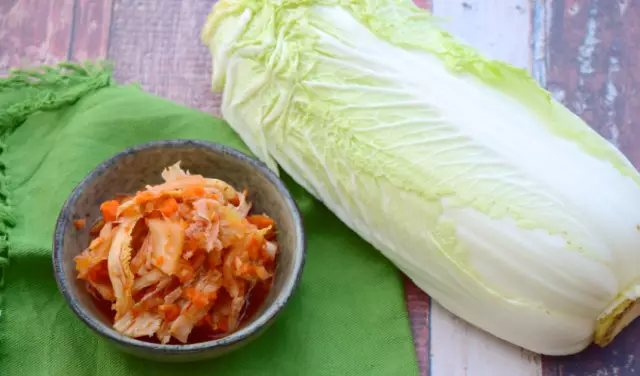- Author Rachel Wainwright [email protected].
- Public 2023-12-15 07:39.
- Last modified 2025-11-02 20:14.
Kimchi

Kimchi is called one of the most popular Korean dishes. It is a spicy seasoned pickled vegetable.
In Korea, no meal is complete without kimchi. The country has a huge industry of this product, museums have been created, kimchi festivals are held and a real cult of this national dish reigns. The Seoul Kimchi Museum displays a collection of 187 types of this product. Jeonju University has the only faculty in the world to teach the technology of preparing this snack.
The exact time of the appearance of this spicy snack is unknown. The first mentions of pickles that are close to the kimchi of our times and came to Korea from China date back to the thirteenth century. Hot red pepper was first introduced to Korea by the Portuguese after the sixteenth century.
Nowadays, red pepper is one of the most important ingredients in most types of kimchi. The first mention of cooking kimchi using red pepper was found in a cookbook published back in 1765. The found recipes for making kimchi practically do not differ from the recipes of the present. In the twentieth century, ingredients were added to this dish that change its color and taste, which led to the creation of a large number of varieties of kimchi.
Cooking kimchi
Kimchi is most often made from radishes, Chinese cabbage, kohlrabi, as well as eggplants, cucumbers and other vegetables. Vegetables are seasoned with onion juice, paprika, ginger and garlic. Some chefs add pine nuts, chestnuts, sesame seeds, seaweed, pears, and even oysters, salted shrimps and octopuses to the dish.
In the kore-saram kitchen, the technology of kimchi preparation has significantly departed from the traditional one. This is due to the high cost or lack of necessary products in their places of residence. Therefore, kimchi kore-saram is made from carrots, zucchini, and white cabbage. Modified kimchi kore-saram has entered the diet of the inhabitants of the CIS countries in the form of Korean salads.
Product varieties vary greatly depending on the ingredients used to make kimchi, the season and geographic region. In northern regions, less red pepper and salt are usually added to this product. Also, seafood is used much less often in the manufacture. In southern regions, such as Gyeongsang-do or Jeolla-do, hot peppers, salt, and spices such as seu-chot (pickled shrimp), small chot (pickled anchovies), and small echoot (anchovy sauce) are used in large quantities. Not all varieties of kimchi are spicy. White kimchi is made from Peking cabbage or radish without adding hot red pepper. These varieties are prepared and served in a special brine. White kimchi is especially popular in summer.
Nutritional value of kimchi
One hundred grams of this product contains 88.4 g of water, 2 g of protein, 0.6 g of fat and 1.3 g of carbohydrates and 1.2 g of fiber. Kimchi also contains phosphorus (28 mg), calcium (45 mg), as well as vitamins B1 (0.03 mg), B2 (0.06 mg), vitamin C (21 mg) and niacin (2.1 mg) …
Kimchi is a low-calorie food. One hundred grams of the dish contains only 32 kcal.
Effects of kimchi on health

According to Health magazine, kimchi is one of the healthiest foods in the world. This snack contains a significant amount of lactic acid bacteria. The bacteria in this product prevent excessive fermentation and keep the growth of pathogens in the intestines. In addition, kimchi is believed to be an effective hangover remedy and a powerful antioxidant. The dish protects the walls of blood vessels from atherosclerosis, reducing the concentration of cholesterol in the blood plasma. Koreans believe that regular consumption of this product contributes to the gradual resorption of fatty deposits.
According to Seoul National University, chickens infected with the bird flu virus recovered after eating food with the same bacteria found in this product. The Korean Institute for Food Research confirmed the increase in the immunity of chickens to the SARS virus as a result of their consumption of lactic acid enzymes kimchi.
South Korea has a fairly high incidence of stomach cancer, which is often attributed to the large amount of salty and spicy foods. The reason is that enzymatic vegetables contain chemical radicals that increase the likelihood of cancer.
Kimchi sauce
Currently, Peking cabbage pickle is used as a separate seasoning. Ingredients for fish and meat dishes are marinated with this sauce. Kimchi sauce gives any dish a rich aroma and pungent flavor. It contains a huge amount of active natural ingredients and vitamins that strengthen the body's immunity and normalize digestion.
Found a mistake in the text? Select it and press Ctrl + Enter.






